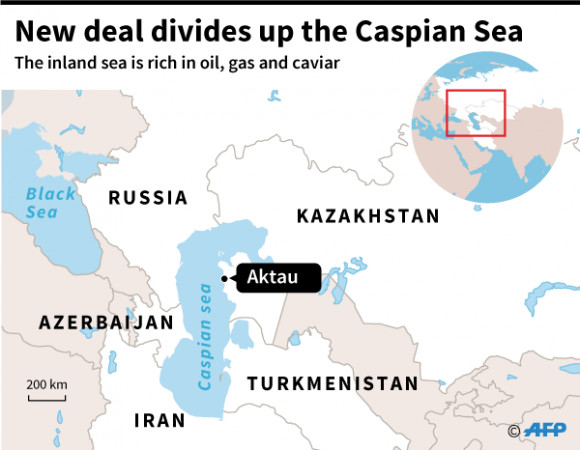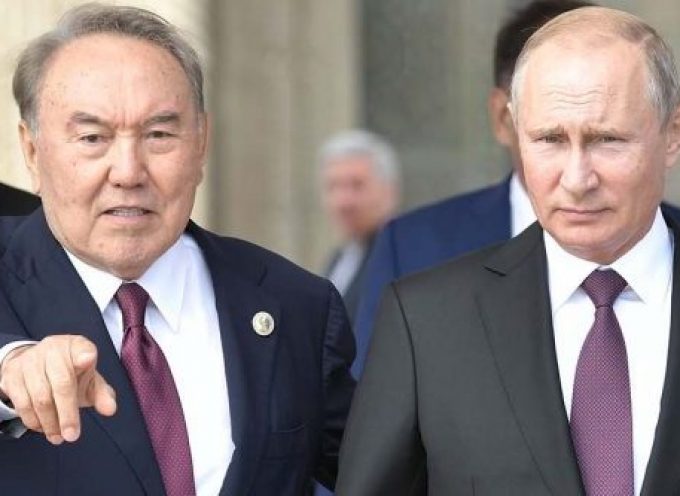
The five states surrounding the sea – Russia, Azerbaijan, Iran, Turkmenistan and Kazakhstan – have reached difficult compromises on sovereign and exclusive rights as well as freedom of navigation
The long-awaited deal on the legal status of the Caspian Sea signed on Sunday in the Kazakh port of Aktau is a defining moment in the ongoing, massive drive towards Eurasia integration.
Up to the early 19th century, the quintessentially Eurasian body of water – a connectivity corridor between Asia and Europe over a wealth of oil and gas – was exclusive Persian property. Imperial Russia then took over the northern margin. After the break up of the USSR, the Caspian ended up being shared by five states; Russia, Iran, Azerbaijan, Turkmenistan and Kazakhstan.
Very complex negotiations went on for almost two decades. Was the Caspian a sea or a lake? Should it be divided between the five states into separate, sovereign tracts or developed as a sort of condominium?
Slowly but surely, the five states reached difficult compromises on sovereign and exclusive rights; freedom of navigation; “freedom of access of all the vessels from the Caspian Sea to the world’s oceans and back” – in the words of a Kazakh diplomat; pipeline installation; and crucially, on a military level, the certitude that only armed forces from the five littoral states should be allowed in Caspian waters.
No wonder then that President Putin, in Aktau, described the deal in no uncertain terms as having “epoch-making significance.”

A sea or a lake?
So is the Caspian now a sea or a lake? It’s complicated; the convention signed in Aktau defines it as a sea, but subject to a “special legal status.”
This means the Caspian is regarded as open water, for common use – but the seabed and subsoil are divided. Still a work in progress, the devil is in the details in sorting out how the seabed is divided.
According to the draft text, published two months ago by Russia’s Kommersant, “the delimitation of the floor and mineral resources of the Caspian Sea by sector will be carried out by agreement between the neighboring and facing states taking into account generally recognized principles and legal norms.”
Stanislav Pritchin, director of the Center for Central Asia and Caucasus Studies at the Russian Academy of Sciences, described this as the best possible compromise, for now.
The maritime boundaries of each of the five states are already set; 15 nautical miles of sovereign waters, plus a further 10 miles (16 km) for fishing. Beyond that, it’s open water.
In Aktau, Kazakh president Nursultan Nazarbayev frankly admitted that even to reach this basic consensus was a difficult process, and the key issue of how to share the Caspian’s underground energy wealth remains far from solved.
Kazakh Foreign Minister Kairat Abdrakhmanov, quoting from the final text, emphasized that, “the methodology for establishing state base lines shall be determined in a separate agreement among all the parties according to this convention on the legal status of the Caspian Sea. This is a key phrase, especially important for our Iranian partners.”
The reference to Iran matters because under the deal Tehran ended up with the smallest share of the Caspian seabed. Diplomats confirmed to Asia Times that up to the last minute President Rouhani’s team was not totally satisfied with the final terms.
That was reflected in Rouhani’s comment that the convention was “a major document” even as it did not solve for good the extremely complex dossier.
What Rouhani did emphasize was how “gratifying” was the fact his Caspian partners privilege “multilateralism and oppose unilateral actions that are developing in some countries.”
That was not only a direct reference to the Caspian partners supporting the JCPOA, or Iran nuclear deal, but also a veiled reference to President Trump’s threat that “anyone doing business with Iran will not be doing business with the United States.”
Rouhani and Nazarbayev in fact held a separate meeting dedicated to increased economic cooperation, including the mutual drive to use their national currencies on trade, bypassing the US dollar.

These waters are off-limits to NATO
Iran-Kazakhstan economic cooperation is bound to follow Iran-Russia parameters. Putin and Rouhani, who enjoy a warm, close personal relationship, spent quite some time in Aktau discussing issues far beyond the Caspian, such as Syria, Gazprom investment in Iranian gas fields, and how to deal with Washington’s sanctions offensive.
Both were adamant in their praise of a key stipulation of the deal; there will be no NATO roaming the Caspian. In the words of Rouhani, “the Caspian Sea only belongs to the Caspian states.” Putin for his part confirmed Russia plans to build a new deepwater port in the Caspian by 2025.
In the turbulent geoeconomic realm that I defined years ago as “Pipelineistan,” the deal will allow a lot of leeway; from now on, pipelines to be laid offshore require consent only from neighboring states, rather than from all “Caspian Five”.
A major consequence is that Turkmenistan may finally be able to lay down its own 300 km-long trans-Caspian underground pipeline to Azerbaijan – a project that was never exactly encouraged by Russia. This pipeline will allow Turkmenistan to diversify from its massive exports to China by tapping the European market via Baku, in direct competition with Gazprom.
Ashgabat may finally be on its way towards a win-win; not only Baku could use more gas imports to compensate for production shortfalls, but Moscow seems inclined to restart imports of Turkmen gas.
From now on, the game to watch in the Caspian is how deeper energy/economic cooperation may go, in the spirit of true Eurasia integration, even with China not directly involved in the affairs of the sea. Chinese companies though are heavily invested in the Kazakhstan oil business and are major importers of Turkmenistan gas.
Historically, Persia always maintained a demographic, cultural and linguistic pull across most of Central Asia. Persia remains one of its organizing principles; Iran is a Central Asian as much as a Southwest Asian power.
This should be contrasted with Caspian nations still heavily influenced by Soviet atheism and Turkish shamanism. A particularly interesting case to watch will be Azerbaijan – which is part of the Western sphere of influence via pipelines such as the BTC (Baku-Tblisi-Ceyhan), which crosses Georgia all the way to the Turkish Eastern Mediterranean.
This was The Art of the Deal – Central Asian-style. What’s already established is that the Caspian 2.0 is a major multilateral win for Eurasia integration.
Pepe Escobar is correspondent-at-large at Asia Times
The 21st Century
The views expressed in this article are solely those of the author and do not necessarily reflect the opinions of The 21st Century

One word says it all, Hallelujah! Let us praise the Lord!